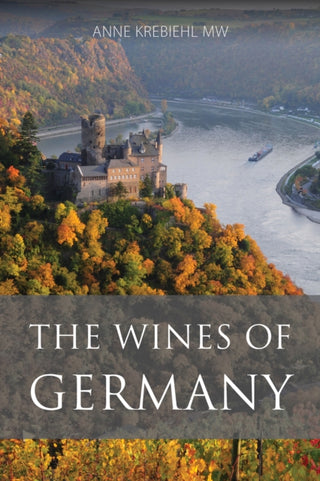-
This historic wine nation at the heart of Europe produces a diverse range of wines – Riesling above all, but also compelling Spätburgunder, aka Pinot Noir, and Silvaner, amongst others. Yet in the minds of many it is still associated with mass-produced sweetish plonk. But following a bruising twentieth century, German wine over the past thirty years has experienced a renaissance. In The Wines of Germany, Master of Wine Anne Krebiehl takes us with her on a journey through vineyards clustered along the country’s many winding rivers to uncover this new world of German wine. She begins with a thorough explanation of German wine law – a subject so complicated that it can alienate all but the most dedicated wine enthusiast – taking a historical perspective and showing how current moves to review the law could considerably simplify it. It is only right that Riesling, the light and aromatic grape synonymous with this country, gets a chapter all to itself, as does Spätburgunder. Plantings of this grape doubled between 1990 and 2010 to make Germany the third-largest grower worldwide. As an enthusiast for Sekt, Krebiehl is keen to explain how far from the tank-produced wines of past decades this sparkling wine has come, with artisan winemakers across the regions returning to the old methods to create bottle-fermented Sekts of quality. Taking the thirteen regions in turn, Krebiehl explains the unique history, geography and climate of each, presenting a selection of some of her favourite producers. From the famed steep slopes of the Mosel, where Riesling reaches its pinnacle of expression, through the largest region, Rheinhessen, home of the infamous Liebfraumilch, to less well-known regions such as Saale-Unstrut and Sachsen, Krebiehl paints a vivid picture of each region’s unique offering, inspiring readers to begin their own explorations.
This historic wine nation at the heart of Europe produces a diverse range of wines – Riesling above all, but also compelling Spätburgunder, aka Pinot Noir, and Silvaner, amongst others. Yet in the minds of many it is still associated with mass-produced sweetish plonk. But following a bruising twentieth century, German wine over the past thirty years has experienced a renaissance. In The Wines of Germany, Master of Wine Anne Krebiehl takes us with her on a journey through vineyards clustered along the country’s many winding rivers to uncover this new world of German wine.
She begins with a thorough explanation of German wine law – a subject so complicated that it can alienate all but the most dedicated wine enthusiast – taking a historical perspective and showing how current moves to review the law could considerably simplify it. It is only right that Riesling, the light and aromatic grape synonymous with this country, gets a chapter all to itself, as does Spätburgunder. Plantings of this grape doubled between 1990 and 2010 to make Germany the third-largest grower worldwide. As an enthusiast for Sekt, Krebiehl is keen to explain how far from the tank-produced wines of past decades this sparkling wine has come, with artisan winemakers across the regions returning to the old methods to create bottle-fermented Sekts of quality.
Taking the thirteen regions in turn, Krebiehl explains the unique history, geography and climate of each, presenting a selection of some of her favourite producers. From the famed steep slopes of the Mosel, where Riesling reaches its pinnacle of expression, through the largest region, Rheinhessen, home of the infamous Liebfraumilch, to less well-known regions such as Saale-Unstrut and Sachsen, Krebiehl paints a vivid picture of each region’s unique offering, inspiring readers to begin their own explorations.

